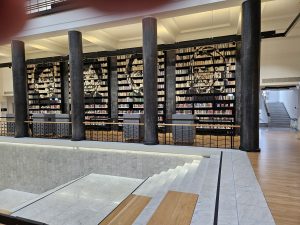The plan was to spend a couple days in the place where Dan’s paternal grandfather, Kazimir Tamkus, came from. Kazimir and his brother Petrus died in the Diamond Mining disaster in Scranton, Pennsylvania in December 1914. Family facts and fancies died with them when the young widow Ona remarried.
Reading the Stones
First stop: the Meižonys cemetery. I knew where it was, a green spot on the Google map, predictably away from wherever the center of town would have been. Stones glistened in the pouring rain. The foliage of great trees offered a little cover as I methodically moved up one row and down the next. It‘s a small cemetery, maybe only a tenth the size of the one in Balbieriškis. Small but well-kept and obviously still in use.
Nearly half the markers bore the legend “Tomkus” or some variation thereof: Tomkus, Tomkai, Tomkiene. I was clearly in the right place. They were comparatively modern, too, most from the later 20th century and into the 21st.
I photographed the headstones, hoping that the steady rain and low light would still allow legibility in the pictures.
Reading Lithuanian
Quite some time ago I had found some books listed on the Internet that seemed useful. A history, Meižonys, by Juozapas Tomkus, looked most intriguing. A cousin of some sort?
I had mentioned to Audrius Tamkus—dear friend and sadly not a relative—that I would be stopping by the museum library in Kaišiadorys to find a copy of that book and perhaps some others. Audrius went over to the Martynas Mažvydas National Library of Lithuania himself, found several books and started scanning. The scans he put in the Dropbox we use to share large files and photographs.
Yes, the text is all Lithuanian. With perseverance, however, and the Google translate app on my phone, there is no obstacle that cannot be overcome.
The Best Laid Plans
When the pas Radvila hotel where I had booked a room for two nights turned out to be intolerable, I moved my shift to Vilnius up by a day. That gave me most of a day to see what I could accomplish in that area. A local merchant recommended the restaurant Toscana for breakfast. When it turned out to be next door to the public library, I took it as a sign.
Welcoming staff settled me at a desk and provided me with the password to their wi-fi. A few hours steady work, and a lot of tedious translation, provided me with a sense of the information available and the difficulties extracting it.
Then it was on to Žiežmariai and the church where the Tomkus/Tamkus weddings and baptisms had most often taken place called.
Meižonys History
The following Sunday, Audrius and I took a few minutes during a lull in young Orestes‘ birthday festivities to review his scans together and compare notes. We were in agreement that Tomkus‘ methodology was difficult for us to sort out. We both noted that there was no discussion at all of the immigrants.
Between 1898 and 1910, or so, three brothers, three of four surviving sons of Jurgis Tomkus–son of Laurynas the son of Motiejus–up and left for Scranton, Pennsylvania. In 1914, two of them were killed in the same mining disaster. Surely it would have been noteworthy that three brothers decamped for America. Wouldn’t such tragic deaths have been reported to the parents left behind?
Didn’t other residents, members of other families, immigrate as well? The village of Meižonys hardly exists now. That decline may well have started at the beginning of the 20th century. It was a moment when young men dodged conscription in the Russian army and agents for American mining and steel companies were actively recruiting workers in the area.
Vilnius Resources
I took a Bolt over to the National Library and a librarian found the book for me and settled me into a reading room. Wi-fi is open access.
As a sidebar, what a beautiful building! It is a classical design but fully modernized on the inside, full of art, possessed of every resource a researcher could want. Or even a casual reader. Or a person evading the unexpected cold. There is a Caffeine just to the left of the entrance where I enjoyed an excellent latte and a mango yogurt with oats and almonds about halfway through my labors.
Call me old-fashioned; I do much better with printed text than with digital images. Meižonys is a substantial volume and Tomkas, a scientist, meteorologist and geologist by training, is above all else fascinated by the land: who lived where and who owned what and when.
My interest is in the time period prior to about 1920. Tomkas relied on the census records from Russia, which was quite helpful as Vasilius Vaseikis, my researcher, had done the same. To my dismay, however, the descendant charts for Dan’s line in the family, were not of interest to him. While the array of children belonging to Laurynas Tomkas and his wife Ona were provided, the only one of their children he charted was Jonas.
Laurynas’ son Jurgis, Dan’s great-grandfather is noted and his children listed, but only the line of his oldest son Andrius is explored further.
More Leaves on the Tree
What is evident throughout the family is just how many children never survived infancy or early childhood. These were poor people; disease and hunger clearly took their toll.
I am going home, however, with lots of reading material in Dropbox and a far grander tree than I had before. I think Dan would have been fascinated. I hope that one of the kids of grandkids is too.







